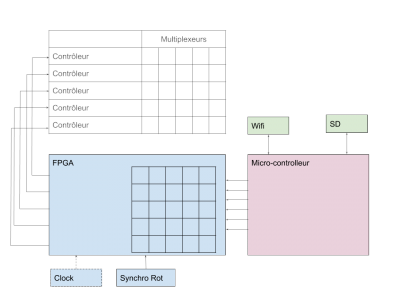In this first post we would like to present the architecture of our project. It includes the choice of the type of components we will need, the way they are connected to each other and our estimations concerning their number.
Dimensioning
We will dimension our components to be able to handle a maximum specification, which we will very probably scale back according to the different bottlenecks we stumble upon during the duration of the project. Keeping last year’s project in mind, we are aiming at a maximum number of LEDs of about 2000, a rotation speed of 50 turns per second and a refreshing speed of each LED of 360 times per rotation. Knowing that and if we take 8 bits per color and 8 bits for brightness, we calculate a maximum bandwidth of about 150MB/s. In practice, we aim at an array of 40 by 30 LEDs in order to have a standard 4:3 display, given that we place the LEDs with the same pixel pitch in height and width.
We will control the LEDs by rectangular blocks. The size of each block is limited by both the number of PINs and the bandwidth of the LED driver we choose. We plan to choose a LED driver with at least the same characteristics as last year’s project: the ability to drive 16 LEDs at the same time with an input bandwidth of 33MHz.

We estimate the Wifi throughput to be limited at 150Mb/s, which implies that we will need to implement a compression algorithm in our future file structure.
Elements choice
We will need:
- a Wifi module in order to stream data to the display
- an SD card reader
- a microcontroller unit in order to communicate with the Wifi and SD cartd reader modules
- an FPGA used to buffer the frames and driver the LED drivers
- a synchronization module in the form of an infra red sensor
- an OS to handle the modules
- voltage converters depending on the choice of components in order to supply accurate voltage to each one

For next time
We will choose the actual reference for each component.
 Alexis
Alexis
Discussions
Become a Hackaday.io Member
Create an account to leave a comment. Already have an account? Log In.